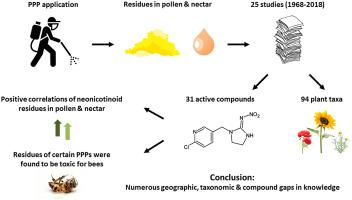Environmental Research ( IF 7.7 ) Pub Date : 2020-07-09 , DOI: 10.1016/j.envres.2020.109873 Elena Zioga 1 , Ruth Kelly 2 , Blánaid White 3 , Jane C Stout 1

|
Exposure to Plant Protection Products, PPPs, (fungicides, herbicides and insecticides) is a significant stressor for bees and other pollinators, and has recently been the focus of intensive debate and research. Specifically, exposure through contaminated pollen and nectar is considered pivotal, as it presents the highest risk of PPP exposure across all bee species. However, the actual risk that multiple PPP residues might pose to non-target species is difficult to assess due to the lack of clear evidence of their actual concentrations. To consolidate the existing knowledge of field-realistic residues detected in pollen and nectar directly collected from plants, we performed a systematic literature review of studies over the past 50 years (1968-2018). We found that pollen was the matrix most frequently evaluated and, of the compounds investigated, the majority were detected in pollen samples. Although the overall most studied category of PPPs were the neonicotinoid insecticides, the compounds with the highest median concentrations of residues in pollen were: the broad spectrum carbamate carbofuran (1,400 ng/g), the fungicide and nematicide iprodione (524 ng/g), and the organophosphate insecticide dimethoate (500 ng/g). In nectar, the highest median concentration of PPP residues detected were dimethoate (1,595 ng/g), chlorothalonil (76 ng/g), and the insecticide phorate (53.5 ng/g). Strong positive correlation was observed between neonicotinoid residues in pollen and nectar of cultivated plant species. The maximum concentrations of several compounds detected in nectar and pollen were estimated to exceed the LD50s for honey bees, bumble bees and four solitary bee species, by several orders of magnitude. However, there is a paucity of information for the biggest part of the world and there is an urgent need to expand the range of compounds evaluated in PPP studies.
中文翻译:

植物花粉和花蜜中的植物保护产品残留:对现有知识的回顾。
接触植物保护产品、PPP(杀菌剂、除草剂和杀虫剂)是蜜蜂和其他传粉媒介的重要压力源,最近成为激烈辩论和研究的焦点。具体来说,通过受污染的花粉和花蜜暴露被认为是关键,因为它在所有蜜蜂物种中呈现出最高的 PPP 暴露风险。然而,由于缺乏关于其实际浓度的明确证据,多种 PPP 残留物可能对非目标物种造成的实际风险难以评估。为了巩固在直接从植物中采集的花粉和花蜜中检测到的实地实际残留物的现有知识,我们对过去 50 年(1968-2018 年)的研究进行了系统的文献回顾。我们发现花粉是最常被评估的基质,在所研究的化合物中,大多数是在花粉样本中检测到的。虽然总体上研究最多的 PPP 类别是新烟碱类杀虫剂,但花粉中残留中位数浓度最高的化合物是:广谱氨基甲酸呋喃 (1,400 ng/g)、杀菌剂和杀线虫剂异菌脲 (524 ng/g)、和有机磷杀虫剂乐果 (500 ng/g)。在花蜜中,检测到的 PPP 残留的最高中值浓度是乐果 (1,595 ng/g)、百菌清 (76 ng/g) 和杀虫剂甲拌磷 (53.5 ng/g)。栽培植物花粉和花蜜中的新烟碱残留量呈强正相关。在花蜜和花粉中检测到的几种化合物的最大浓度估计超过了 LD 虽然总体上研究最多的 PPP 类别是新烟碱类杀虫剂,但花粉中残留中位数浓度最高的化合物是:广谱氨基甲酸呋喃 (1,400 ng/g)、杀菌剂和杀线虫剂异菌脲 (524 ng/g)、和有机磷杀虫剂乐果 (500 ng/g)。在花蜜中,检测到的 PPP 残留的最高中值浓度是乐果 (1,595 ng/g)、百菌清 (76 ng/g) 和杀虫剂甲拌磷 (53.5 ng/g)。栽培植物花粉和花蜜中的新烟碱残留量呈强正相关。在花蜜和花粉中检测到的几种化合物的最大浓度估计超过了 LD 虽然总体上研究最多的 PPP 类别是新烟碱类杀虫剂,但花粉中残留中位数浓度最高的化合物是:广谱氨基甲酸呋喃 (1,400 ng/g)、杀菌剂和杀线虫剂异菌脲 (524 ng/g)、和有机磷杀虫剂乐果 (500 ng/g)。在花蜜中,检测到的 PPP 残留的最高中值浓度是乐果 (1,595 ng/g)、百菌清 (76 ng/g) 和杀虫剂甲拌磷 (53.5 ng/g)。栽培植物花粉和花蜜中的新烟碱残留量呈强正相关。在花蜜和花粉中检测到的几种化合物的最大浓度估计超过了 LD 花粉中残留中位数浓度最高的化合物是:广谱氨基甲酸酯呋喃(1,400 ng/g)、杀真菌剂和杀线虫剂异菌灵(524 ng/g)和有机磷杀虫剂乐果(500 ng/g)。在花蜜中,检测到的 PPP 残留的最高中值浓度是乐果 (1,595 ng/g)、百菌清 (76 ng/g) 和杀虫剂甲拌磷 (53.5 ng/g)。栽培植物花粉和花蜜中的新烟碱残留量呈强正相关。在花蜜和花粉中检测到的几种化合物的最大浓度估计超过了 LD 花粉中残留中位数浓度最高的化合物是:广谱氨基甲酸酯呋喃(1,400 ng/g)、杀真菌剂和杀线虫剂异菌灵(524 ng/g)和有机磷杀虫剂乐果(500 ng/g)。在花蜜中,检测到的 PPP 残留的最高中值浓度是乐果 (1,595 ng/g)、百菌清 (76 ng/g) 和杀虫剂甲拌磷 (53.5 ng/g)。栽培植物花粉和花蜜中的新烟碱残留量呈强正相关。在花蜜和花粉中检测到的几种化合物的最大浓度估计超过了 LD 检测到的 PPP 残留的最高中值浓度是乐果 (1,595 ng/g)、百菌清 (76 ng/g) 和杀虫剂甲拌磷 (53.5 ng/g)。栽培植物花粉和花蜜中的新烟碱残留量呈强正相关。在花蜜和花粉中检测到的几种化合物的最大浓度估计超过了 LD 检测到的 PPP 残留的最高中值浓度是乐果 (1,595 ng/g)、百菌清 (76 ng/g) 和杀虫剂甲拌磷 (53.5 ng/g)。栽培植物花粉和花蜜中的新烟碱残留量呈强正相关。在花蜜和花粉中检测到的几种化合物的最大浓度估计超过了 LD蜜蜂、大黄蜂和四种独居蜂种的50 年代,提高了几个数量级。然而,世界上大部分地区的信息匮乏,迫切需要扩大 PPP 研究中评估的化合物范围。











































 京公网安备 11010802027423号
京公网安备 11010802027423号